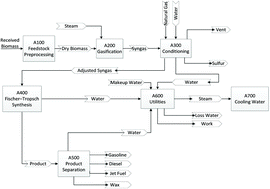Economic and environmental potentials for natural gas to enhance biomass-to-liquid fuels technologies
Abstract
With the increased availability of low-cost natural gas (NG), co-conversion of natural gas and biomass-to-liquid (GBtL) fuels has gained interest from industry and the U.S. Department of Energy due to the potential to improve liquid fuel yields while lowering greenhouse gas (GHG) emissions. In this article, we explore the conceptual process design and cost comparison of liquid biofuels using both biomass-derived gas intermediates and natural gas, as well as studies on quantification and assessment of sustainability metrics including life cycle/GHG emissions. Additionally, we have performed sensitivity analysis to understand the impact from variations of the biomass-to-NG ratio, design assumptions, and NG prices on process economics. This is to understand key cost drivers, parameters influencing the environment, and to discover opportunities to optimize the use of NG along with biomass. Our analysis shows that different blending ratios of natural gas/biomass have a large effect on the economic and environmental performance of the GBtL fuels. Co-processing NG enables the economic feasibility of converting biomass to the liquid fuel but at the expense of environmental sustainability. This study determined that the maximum amount of NG that can be blended with biomass would be 28% to meet the Renewable Fuel Standard (RFS) GHG emission targets for advanced fuels, with a resulting minimum fuel selling price (MFSP) of $2.75 per gallon gasoline equivalent (GGE). In addition, the paper demonstrates the impact of the co-conversion operation on equipment design, raw materials, utility consumption, and overall process economic performance for the GBtL system. A secondary outcome: This study shows that renewable liquid fuel could be cost competitive with fossil-derived liquid fuel if further improvements and optimizations could be made to blending ratios of NG, optimization of heat integration of the process, and reduction of excess hydrogen and excess electricity production.



 Please wait while we load your content...
Please wait while we load your content...